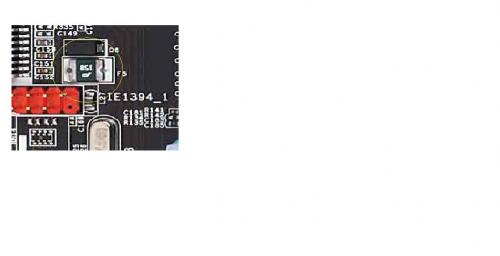
Motherboard Component
Started by
chickmazta
, Jan 17 2011 11:35 AM
#1

 Posted 17 January 2011 - 11:35 AM
Posted 17 January 2011 - 11:35 AM

#2

 Posted 17 January 2011 - 11:41 AM
Posted 17 January 2011 - 11:41 AM

Not certain but it looks like a "surface mount capacitor".
#3

 Posted 19 January 2011 - 12:54 AM
Posted 19 January 2011 - 12:54 AM

That's also what I think of it, but someone told me it looks like SMD Resistor. I'm still trying to figure out what this component is. I showed the motherboard to some electronics shop here and it seems that they don't have any idea what it is...how unfortunate...tnx for the idea.
PS: Its an Asus K8V SE Deluxe motherboard.
PS: Its an Asus K8V SE Deluxe motherboard.
#4

 Posted 19 January 2011 - 08:27 AM
Posted 19 January 2011 - 08:27 AM

It could be. A sharper image might help.but someone told me it looks like SMD Resistor
#5

 Posted 20 January 2011 - 07:13 PM
Posted 20 January 2011 - 07:13 PM

I'll try to find the best image I can get. This was the component that got burned, I don't know if it would work if I replace it. Tnx
#6

 Posted 20 January 2011 - 08:59 PM
Posted 20 January 2011 - 08:59 PM

The problem is, a fault somewhere else in the circuit could have created a high-current condition that fried the device. Replacing it may just result in the new one getting fried. Assuming you could get the correct replacement. And note soldering on multi-layered circuit boards presents unique challenges too.
#7

 Posted 21 January 2011 - 12:10 AM
Posted 21 January 2011 - 12:10 AM

Tnx for the advice, the one responsible for that is the technician they previously called. He used an extension of wire from the processor fan to the motherboard itself, the original fan has 3 pins (correct me if I'm wrong) this is a stock amd fan. Now, 1 of the wires had been cut and tapped to a part of the board and the other 2 to the cpu fan pin, I don't know why he did that maybe that caused the short. Lazy enough to replace the connector itself or the whole fan itself. I'll get to you sir if something might came up. tnx again!
#8

 Posted 21 January 2011 - 10:09 AM
Posted 21 January 2011 - 10:09 AM

He taped it to the board??? That's sad. Note a fan only needs two wires to spin. The third is often use to send sensor data (to report rotation speed) and sometimes for speed control (if motherboard supports that). So, using just two wires should not hurt anything, but if that 3rd touched something it should not have, that could cause a problem.
#9

 Posted 23 January 2011 - 12:37 AM
Posted 23 January 2011 - 12:37 AM

Good day, not taped but tapped he soldered it instead, I think I figure out what component it is. Last night a friend came and asked me if I can make his old pc work again, he needs it just for typing. Its an ancient pentium 4 1.8 Ghz, at first It won't boot so I decided to remove the side panel and take a look at it. It was so dirty like cotton of black ash. After cleaning I noticed the word fuse on the board, beside it, was the component I was trying to figure out. I investigated furthermore and I found 4 other component like that labeled as fuse. The only difference is that "P 160" is printed on the component, mine was "P 150"
I'll google it a little more and get back as soon as I can.
I'll google it a little more and get back as soon as I can.
#10

 Posted 23 January 2011 - 08:30 AM
Posted 23 January 2011 - 08:30 AM

Ah! Sorry. That certainly could be a "fusible link" and I assume that would be 150mA (milliamp). If so, that would mean that some other component has shorted out, causing a drop in resistance. And Ohms Law says when voltage is constant, and resistance drops, current goes up. And when the current in that circuit exceeded 150mA, the heat generated melted the link. So simply replacing the fuse is not likely to fix the problem unless that just happened to be a bad fuse.Good day, not taped but tapped he soldered it instead
#11

 Posted 23 January 2011 - 11:10 AM
Posted 23 January 2011 - 11:10 AM

Tnx again sir! Now I need to find out what caused the fuse to melt out. Oh I forgot I have little knowledge about electronics...lol And if I do fix it I'll let you know. have a good day
#12

 Posted 23 January 2011 - 02:47 PM
Posted 23 January 2011 - 02:47 PM

Yeah - please do!And if I do fix it I'll let you know
#13

 Posted 28 January 2011 - 01:41 PM
Posted 28 January 2011 - 01:41 PM

Greetings its been awhile. I've got good news and bad ones. The good news is it didn't got fried when I powered it up. Fans are spinning now and hard drives are rounding. The bad news is no luck of booting from the motherboard. I already replaced the component which I took from a dead motherboard, still no post and no display.
Maybe I still need to find which component could still be the culprit. Got a question again, I'm not sure which of the bridge are controlling the integrated video the north or the south? Maybe I could determine which part of those needs replacement. I'm still hoping to fix this one, I'll never give up unless theres no hope. Back to you guys again soon. tnx again!
Maybe I still need to find which component could still be the culprit. Got a question again, I'm not sure which of the bridge are controlling the integrated video the north or the south? Maybe I could determine which part of those needs replacement. I'm still hoping to fix this one, I'll never give up unless theres no hope. Back to you guys again soon. tnx again!
#14

 Posted 28 January 2011 - 01:49 PM
Posted 28 January 2011 - 01:49 PM

The northbridge normally controls the high speed buses so that would include AGP and PCIe graphics. Integrated graphics are separate devices on the bus, even if integrated.
#15

 Posted 29 January 2011 - 02:37 PM
Posted 29 January 2011 - 02:37 PM

It's labeled F5 so that leads me to believe its a fuse. Fuses are "F" something, capacitors "C", resistors "R". As Digerati stated, something has failed that is making the current too high on that path and the fuse is blowing.
Similar Topics
0 user(s) are reading this topic
0 members, 0 guests, 0 anonymous users
As Featured On:
















 Sign In
Sign In Create Account
Create Account

